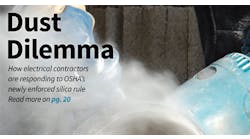When you find yourself stumped by the Code, just e-mail your question to [email protected] or visit www.mikeholt.com. Your question and Mike's answer may be posted in a future Code Q&A column.
Q. I understand there’s a provision in the Code prohibiting the "daisy-chain" feed-through connections of conductors on receptacles and switches. In other words, all wiring at receptacles and switches must be pigtailed. Supposedly, the rule was intended to prevent the removal of a wiring device from interrupting the continuity of the circuit involved. Is there such a rule?
A. No, but in multiwire branch circuits, the removal of a wiring device, such as a receptacle, may not interrupt the continuity of the grounded (neutral) conductor [300.13(B)]. Therefore, the grounded (neutral) conductors must be spliced together and a pigtail must be provided for device terminations. The opening of the ungrounded (hot) or grounded (neutral) conductor of a two-wire circuit during the replacement of a device doesn’t cause a safety hazard, so pigtailing these conductors isn’t required by the NEC.
Be careful - if the continuity of the grounded (neutral) conductor of a multiwire circuit is interrupted (open), the resultant over- or undervoltage could cause a fire and/or destruction to electrical equipment.



